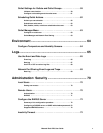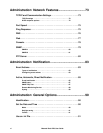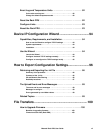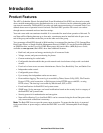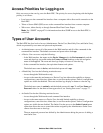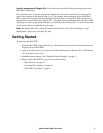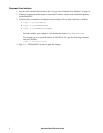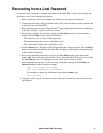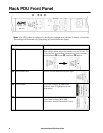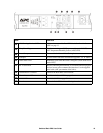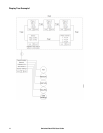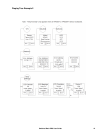Switched Rack PDU User Guide5
Establish Network Settings
Note: Disregard the procedures described in this section if you have StruxureWare Data Center Expert
as part of your system. See the documentation for your StruxureWare Data Center Expert for more
information.
You must configure the following TCP/IP settings before the Rack PDU can operate on a network:
• IP address of the Rack PDU
• Subnet mask
• Default gateway
Note: If a default gateway is unavailable, use the IP address of a computer that is located on the
same subnet as the Rack PDU and that is usually running. The Rack PDU uses the default
gateway to test the network when traffic is very light.
Note: Do not use the loopback address (127.0.0.1) as the default gateway address for the Rack
PDU. It disables the card and requires you to reset TCP/IP settings to their defaults using a local
serial login.
See “Watchdog Features” on page 3 for more information about the watchdog role of the default
gateway.
TCP/IP configuration methods
Use one of the following methods to define the TCP/IP settings needed by the Rack PDU:
• “Device IP Configuration Wizard” on page 102
• “DHCP and BOOTP configuration” on page 5
• “Command Line Interface” on page 7
INI file utility
You can use the INI file export utility to export INI file settings from configured Rack PDUs to one or
more unconfigured Rack PDUs. For more information, see “Use an .ini File” on page 99.
DHCP and BOOTP configuration
The default TCP/IP configuration setting, DHCP, assumes that a properly configured DHCP server is
available to provide TCP/IP settings to Rack PDU. You can also configure the setting for BOOTP.
A user configuration (INI) file can function as a BOOTP or DHCP boot file. For more information, see
“Use an .ini File” on page 99.
If neither of these servers is available, see “Device IP Configuration Wizard” on page 102 or “Command
Line Interface” on page 7.
BOOTP. For the Rack PDU to use a BOOTP server to configure its TCP/IP settings, it must find a
properly configured RFC951-compliant BOOTP server.
In the BOOTPTAB file of the BOOTP server, enter the Rack PDU’s MAC address, IP address, subnet
mask, and default gateway, and, optionally, a bootup file name. Look for the MAC address on the bottom
of the Rack PDU or on the Quality Assurance slip included in the package.



